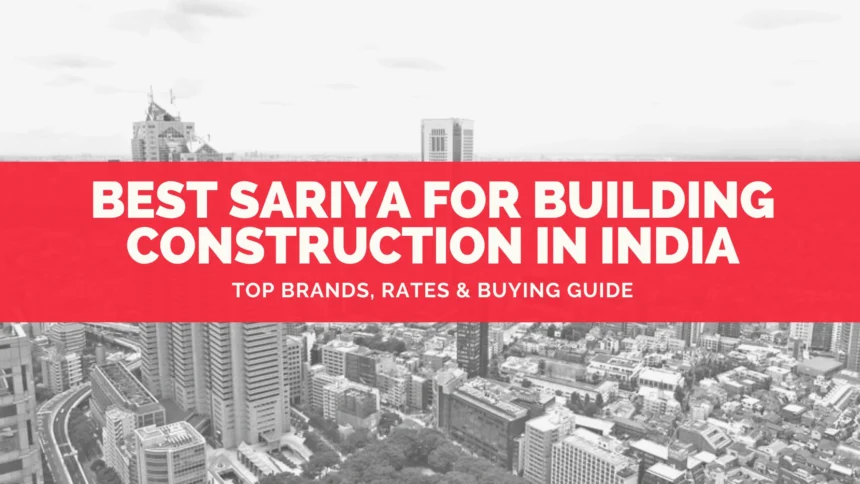Sariya, known as steel reinforcement bars or TMT bars, is the backbone of any durable and safe concrete structure. Whether it’s a residential home, a commercial complex, or vital infrastructure, choosing the right sariya brand at the optimal sariya bhav today can make all the difference in project quality and cost-efficiency.
What Is RCC Sariya and Why It Matters
RCC sariya stands for Reinforced Cement Concrete sariya—steel bars embedded in concrete to provide tensile strength. Concrete resists compression but fails under tension; sariya bars bridge this gap by carrying tensile loads, enhancing ductility, and preventing cracks.
Key attributes of high-quality TMT bars:
- Yield Strength: Ability to withstand load before permanent deformation.
- Ductility: Flexibility to bend under stress without fracturing—vital in seismic zones.
- Corrosion Resistance: Improves longevity in harsh environments.
- Thermo-Mechanical Treatment: Advanced quenching and tempering methods ensure a tough outer layer and ductile core.
Investing in premium brands (e.g., Tata Tiscon, JSW Steel) ensures compliance with BIS standards (IS 1786) and superior structure performance.
Factors Influencing Sariya Bhav Today
Monitoring sariya bhav today involves understanding:
- Raw Material Prices: Iron ore and scrap steel markets.
- Global Steel Trends: International demand, export policies, and currency rates.
- Transport & Logistics: Fuel costs and freight charges.
- Regulatory Environment: Import duties, GST rates, and export controls.
- Seasonal Demand: Post-monsoon and winter construction booms.
These factors drive daily fluctuations in aaj sariya ka rate, making timely rate checks crucial for budget planning.
Aaj Ka Sariya Ka Rate: Market Snapshot
Below is an indicative sariya ka aaj ka rate for 10 mm bars from prominent brands across major cities:
| Brand | Rate (₹/kg) | Quote Time | City |
|---|---|---|---|
| Tata Tiscon | 75 | 10:00 AM | Bengaluru |
| JSW Steel | 74 | 10:00 AM | Mumbai |
| Jindal Panther | 68 | 11:00 AM | Delhi |
| SRMB | 60 | 12:00 PM | Kolkata |
| Mangla | 66 | 11:30 AM | Jaipur |
| KDS | 67 | 12:15 PM | Chennai |
| Rathi | 65 | 12:30 PM | Pune |
| Kamdhenu | 66.5 | 11:45 AM | Hyderabad |
| Meenakshi | 65.5 | 10:15 AM | Ahmedabad |
| SAIL | 74 | 10:30 AM | Patna |
Note: Local dealer rates may vary slightly.
Top 10 Sariya Companies and Their Rates
Indian builders trust these brands for consistent quality, availability, and competitive pricing. Below is an in-depth look at each, including current rates, standout features, and the pros and cons to help you make an informed choice.
1. Tata Tiscon (₹75/kg)
Features: Thermo-mechanically treated bars, high ductility, earthquake-resistant design, superior bond strength.
Pros:
- Exceptional ductility and yield strength ensure structural safety in seismic zones.
- Wide dealer network and reliable logistics minimize delivery delays.
- Consistent quality backed by rigorous BIS 1786 compliance.
Cons:
- Premium pricing may impact tight project budgets.
- Higher minimum order quantities at some dealers.
2. JSW Steel (₹74/kg)
Features: Corrosion-resistant coating, uniform rib pattern, BIS 1786 and 432 specifications, robust national distribution.
Pros:
- Excellent anti-corrosion properties reduce long-term maintenance.
- Competitive pricing for premium-grade bars.
- Strong after-sales support and online rate transparency.
Cons:
- Slightly limited size availability in some regional depots.
- Price volatility during peak demand periods.
3. Jindal Panther (₹68/kg)
Features: Fe 550D grade, uniform ribs for superior bonding, excellent weldability, eco-friendly production.
Pros:
- Good value-for-money with high-grade steel.
- Ideal for large infrastructure and high-rise projects due to Fe 550D rating.
- Lower carbon footprint manufacturing process.
Cons:
- Slightly lower ductility compared to top-tier TMT bars.
- Availability may be limited in remote locations.
4. SRMB (₹60/kg)
Features: Fe 500+ and Fe 550 grades, eco-friendly mills, budget-friendly pricing.
Pros:
- Lowest rate among top brands, ideal for economy projects.
- Multiple grade options suit various structural requirements.
- Green manufacturing processes reduce environmental impact.
Cons:
- Moderate ductility and tensile strength compared to premium bars.
- Quality consistency can vary between plant locations.
5. Mangla (₹66/kg)
Features: Fe 500 grade, low carbon footprint, steady mangla sariya rate with transparent pricing.
Pros:
- Stable pricing helps in precise cost estimation.
- Good fatigue resistance suitable for dynamic loads.
- Strong presence in North and Central India.
Cons:
- Limited availability of higher grades (Fe 550+).
- Slightly higher deviation in bar dimensions reported by some contractors.
6. KDS (₹67/kg)
Features: Cold-twisted plain bars, rust-resistant finish, enhanced anchorage.
Pros:
- Excellent rust protection prolongs service life.
- Cold twisting improves tensile strength.
- Preferred for residential and light commercial structures.
Cons:
- Not available in all major metro markets.
- Higher surface hardness can reduce weldability.
7. Rathi (₹65/kg)
Features: Precision-rolled TMT bars, high elongation, consistent yield strength.
Pros:
- Tight diameter tolerance ensures uniform reinforcement layouts.
- Good elongation properties absorb dynamic stress.
- Competitive mid-range pricing.
Cons:
- Slightly lower corrosion resistance compared to coated bars.
- Smaller production capacity limits bulk order fulfillment.
8. Kamdhenu (₹66.5/kg)
Features: Pascal technology rolling, rust-preventive oil coating, wide size range from 8 mm to 32 mm.
Pros:
- Comprehensive size availability for all structural needs.
- Rust-preventive coating enhances shelf life and on-site storage.
- Consistent mechanical properties across batches.
Cons:
- Oil coating may require cleaning before welding.
- Marginally higher price for small-diameter bars.
9. Meenakshi (₹65.5/kg)
Features: BIS-tested bars, high fatigue resistance, dynamic load endurance, regional manufacturing advantage.
Pros:
- Excellent performance under cyclic loads.
- Strong regional support in Western India reduces lead times.
- Transparent quality test certificates at delivery.
Cons:
- Limited national presence; availability primarily in Gujarat and Maharashtra.
- Occasional price upticks during festive seasons.
10. SAIL (₹74/kg)
Features: PSGL grade, government-backed quality audits, wide distribution network.
Pros:
- High trust in public-sector credibility and quality assurance.
- Consistent supply even during market shortages.
- Compliant with multiple BIS standards.
Cons:
- Price often aligned with market peaks due to public-sector pricing norms.
- Less flexibility on negotiated bulk discounts.
Life Cycle of Sariya: From Mill to Recycling Life Cycle of Sariya: From Mill to Recycling
- Extraction: Iron ore mining and scrap collection.
- Smelting: Blast or electric arc furnaces produce molten steel.
- Casting & Rolling: Billets form; rolling mills shape bars.
- Quenching & Tempering: Rapid cooling and core tempering create TMT bars.
- Processing: Cutting, bundling, and rust-preventive coating.
- Distribution: Rail, road, and shipping to dealers.
- Installation: Tying within concrete framework.
- Service Life: 50+ years of corrosion-resistant performance.
- Demolition & Recycling: Steel scrap recovery and remelting.
High-grade 10 mm sariya from leading brands ensures maximum longevity and safety.
Why Choose Quality Sariya
- Safety: Meets seismic and load-bearing standards.
- Longevity: Resists corrosion, saving on repairs.
- Cost-Efficiency: Lower lifecycle costs and maintenance.
- Eco-Conscious: Steel’s recyclability supports green construction.
Securing the best sariya bhav today for premium bars leads to durable, worry-free structures.
FAQs
How is sariya rate determined?
The daily TMT bar price is influenced by iron ore and scrap steel market rates, international steel demand, currency fluctuations (especially USD/INR), transportation costs, and local GST slabs. Major suppliers adjust their quotes each morning based on aggregated raw material and logistics costs.
What factors should I consider when choosing bar diameter (e.g., 10 mm vs. 12 mm)?
Your selection depends on structural load requirements: residential slabs and light beams often use 10 mm or 12 mm bars, whereas larger beams, columns, and industrial structures call for 16 mm–20 mm bars. Always follow your structural engineer’s specifications to match bending moments and shear forces.
What is the difference between Fe 500, Fe 550, and Fe 550D grades?
Fe 500 and Fe 550 denote minimum yield strengths of 500 MPa and 550 MPa, respectively. The “D” in Fe 550D indicates enhanced ductility for seismic zones, allowing the bar to deform extensively before failure. Higher-grade bars improve load capacity but cost more.
How can I verify the authenticity of TMT bars?
Check for BIS certification marks (IS 1786) stamped at regular intervals; genuine bars carry clear logos, batch numbers, and mill traces. Request mill test certificates (MTC) from suppliers, which detail mechanical properties, chemical analysis, and batch traceability.
What is the best way to store sariya on-site?
Store bundles off the ground using wooden or concrete sleepers to prevent moisture-induced corrosion. Cover with tarpaulin in ventilated conditions to avoid water pooling. Rotate stock on a first-in, first-out basis to minimize long-term exposure.
Are there savings when placing bulk orders for Sariya?
Yes, suppliers often provide tiered discounts for orders above 100 MT. Negotiable terms include waiver of freight charges, on-site cutting, and deferred payment options. Consolidate requirements across multiple projects to maximize volume-based rebates.
How do TMT bars compare to mild steel bars?
TMT bars undergo quenching and tempering, resulting in a tough outer layer and ductile core with superior tensile strength and corrosion resistance. Mild steel bars lack these properties, making them unsuitable for seismic zones and heavy-load applications.
What is the applicable GST rate on sariya purchases?
TMT bars attract a 18% GST (12% central plus 6% state), categorized under “steel products.” Some dealers include GST in their quoted sariya bhav today; always confirm if the price is inclusive or exclusive of taxes.
How can I prevent corrosion of sariya in coastal areas?
In high-humidity zones, opt for epoxy-coated or galvanized TMT bars. Additionally, apply corrosion inhibitors in concrete mixes and ensure adequate concrete cover (minimum 50 mm) over reinforcement to reduce chloride ingress.
What happens to sariya after demolition? Can it be recycled?
Steel is 100% recyclable. Post-demolition, reinforcement bars are cleaned of concrete, cut, and sold as scrap at market rates (typically 60–70% of the prevailing sariya price). Recycled scrap feeds electric arc furnaces for new bar production, closing the sustainability loop.
Conclusion
Choosing the right sariya brand and monitoring aaj ka sariya ka rate are crucial for safe, cost-effective construction. From Tata Tiscon to SAIL, each of the 10 best companies offers unique advantages. Understanding the life cycle of sariya and investing in premium bars will secure your building’s integrity and longevity.





